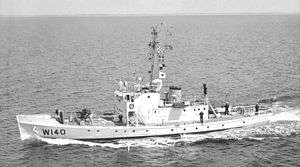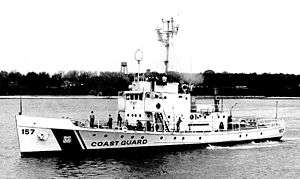Active-class patrol boat
 Active class patrol boat, 1962 | |
| Class overview | |
|---|---|
| Name: | Active-class patrol boat |
| Builders: | American Brown Boveri Electric Corporation, Camden, New Jersey |
| Operators: | |
| Built: | 1926–1927 |
| In commission: | 1927–1978 |
| Completed: | 35 |
| Lost: | 3 |
| Retired: | 32 |
| General characteristics | |
| Type: | Patrol boat |
| Displacement: | 232 long tons (236 t) |
| Length: | 125 ft (38 m) |
| Beam: | 23 ft 6 in (7.16 m) |
| Draft: | 7 ft 6 in (2.29 m) |
| Propulsion: | 2 × 6-cylinder, 300 hp (224 kW) engines |
| Speed: |
|
| Range: |
|
| Complement: | 3 officers, 17 men (1960) |
| Armament: |
|
The Active-class patrol boat was one of the most useful and long-lasting classes of United States Coast Guard cutters. Of the 35 built in the 1920s, 16 were still in service during the 1960s. The last to be decommissioned from active service was the Morris in 1970; the last in actual service was the Cuyahoga, which sank after an accidental collision in 1978.
Design
They were designed for trailing the "mother ships" along the outer line of patrol during Prohibition. They were constructed at a cost of $63,173 each. They gained a reputation for durability that was only enhanced by their re-engining in the late 1930s; their original 6-cylinder diesels were replaced by significantly more powerful 8-cylinder units that used the original engine beds and gave the vessels an additional 3 knots. All served in World War II, but two, the Jackson and Bedloe, were lost in a storm in 1944. Ten were refitted as buoy tenders during the war and reverted to patrol work afterward.
Originally designated WPC, for patrol craft, they were re-designated WSC, for sub chaser, in February 1942, during World War II. The "W" appended to the SC (Sub Chaser) designation identified vessels as belonging to the U.S. Coast Guard. Those remaining in service in May 1966 were re-designated as medium endurance cutters, WMEC.[1]
Gallery
References
Notes
- ↑ "WPC125 Active Cutters (1927)". Retrieved 1 January 2012.
Bibliography
- USCGC Cahoone (1927) at US Coast Guard Historian, which cites:
- Cutter History File. USCG Historian's Office, USCG HQ, Washington, D.C.
- Dictionary of American Naval Fighting Ships. Washington, DC: USGPO.
- Robert Scheina. U.S. Coast Guard Cutters & Craft of World War II. Annapolis, MD: Naval Institute Press, 1982.
- Robert Scheina. U.S. Coast Guard Cutters & Craft, 1946–1990. Annapolis, MD: Naval Institute Press, 1990.
- Rum Runners, U-Boats and Hurricanes: The Complete History of the Coast Guard Cutter Bedloe and Jackson.
- Brian Galecki, ISBN 9780976922308, Publisher: Pine Belt Publishing, Publication date:12/19/2005

